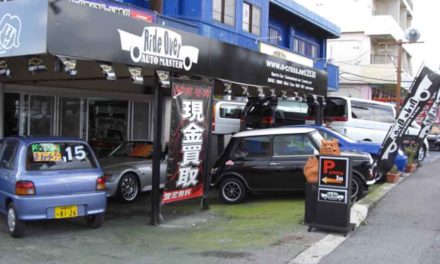So you find yourself on the beautiful little island of Okinawa! But, unlike what you may have been told, it’s not all that small, not at all like Australia, where you can walk anywhere (unless I’ve been misinformed) and you discover you need wheels to get around. First though, you need to . . .
Find A Reputable Dealer
If you’re like many, your first stop might be at a major dealer right outside a base gate. But if that’s also your last stop, you may be making a costly mistake. These dealers have great locations, get more customers, and, though some offer lengthy warranties, their prices are usually thousands higher than less well-known dealers. Here, as anywhere, it pays to shop around.
A Valuable Tip for the Car Shopper
Money in hand and eager to part with it, you should also take with you an equivalent amount in the form of CAUTION. In Okinawa, as anywhere, it is important to pay close attention to what you’re being told, which is to say, SOLD. Not only to what is being said, but even how it is being said. In some instances, you should follow your gut reaction. If the person you are talking with seems inconsistent, misleading, or simply unclear, you should BEWARE. Don’t hesitate to ask pointed questions and insist upon clarification. If you cannot get it, then move on.
Figuring Out The Year Of The Vehicle
Like many people, you may be at a loss when trying to figure out if the car you are looking at is a ’99 or ’05 model. Well, if the year is displayed as 9, just add the posted year to 1988. For example, if it says H9 or 9, add that number to 1988 and you would get 1997.
Since originally writing this a new Emperor has taken his seat. The Reiwa Dynasty started in May, 2019. Since we are only in the 4th year you probably won’t see one listed as R1 yet.
Pricing
When shopping for a car on the local economy you’ll notice prices posted in the form of large one or two digit numbers. For example, 54 means 540,000 yen (divide by the current dollar/yen rate). Add $650-$900 for the JCI and 10% for tax to arrive at a good idea of the total price. If all the signs are in Japanese however, they may not be familiar with selling to the American military and you may run into problems getting the car registered on base.
Test Drives?
Once you find what you’re looking for, you might expect to take it for a test drive. Unfortunately, in Japan it’s not legal to simply slap on dealer plates and hit the road. Only if the car has current registration, not usually the case, will you be able to take a test drive.
Inspections and Fees
Most cars, SUVs, and vans require a 2 year GOJ (Government of Japan) inspection, known as a JCI (Japanese Compulsory Insurance). The JCI consists of the required insurance policy and a safety inspection. Trucks and some 4X4s require a yearly JCI but it and the annual road tax is cheaper. JCI inspections costs range from about $350 if you do it yourself, up to $700 or higher to have done. Don’t hesitate to venture off base to a local garage to get it done and save yourself some time and trouble.
Road Tax Fees
From 1 April every year, all registered vehicles in Japan are required to pay a Road Tax. The Road Tax is calculated according to license plate series, engine size, and vehicle dimensions. The series number appears at the top of the license plate and on the vehicle title. The seller should be able to show this on the Japanese or US Military title, depending on the vehicle’s registration. The road tax can run from about $75 to $150, depending upon the current exchange rate, for SOFA status individuals, which is much lower than the $350 – $500 average the Japanese pay.
Recycle Fee
There is one additional cost to consider when buying a vehicle, this is the Recycle Fee. Instituted in early 2005, the Recycle Fee is intended to cover the cost of recycling a junked vehicle. If the car you are considering buying doesn’t already have a recycle fee certificate, then you will have to pay the fee the next time JCI is performed on the car. This could cost you from 8,000 to 16,000 (big cars with multi-airbags being higher).
Written by Dan McMilan
![]()

























Leave a reply